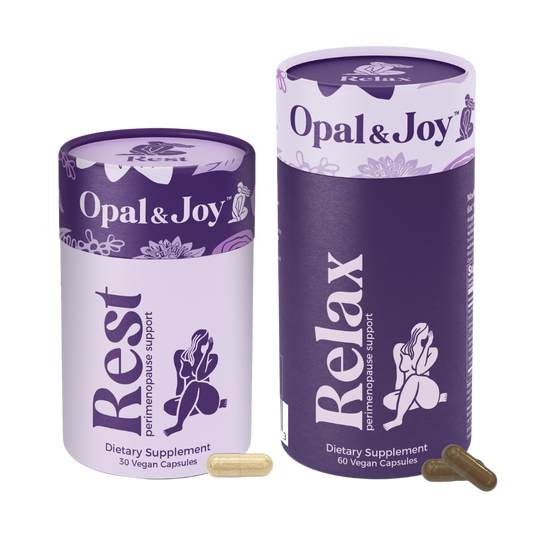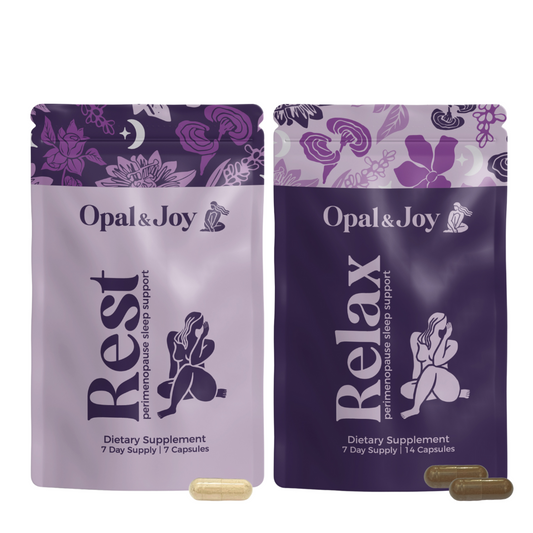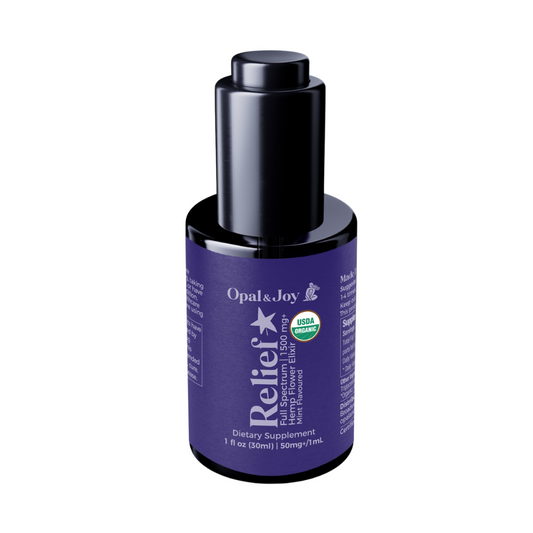Perimenopause & Sleep
For many women, the first signs of perimenopause aren’t hot flashes or missed periods; it's sleep disruption. Waking at 3 am with your mind racing, sleep cycles are lighter, more fragmented and never quite refreshing. These changes aren’t in your head. They’re the direct result of the complex hormonal fluctuations that reshape your body and brain during midlife.
Across studies, as many as 60% of women in perimenopause report sleep disruption, making it one of the most common and least discussed symptoms of this life stage. Yet, research also shows that with the right knowledge and targeted strategies, restful, restorative sleep is possible again.
This guide to perimenopause and sleep brings together the most trusted, evidence-based research on perimenopause and sleep, blending medical insights from the North American Menopause Society (NAMS), International Menopause Society (IMS), Study of Women’s Health Across the Nation (SWAN), and other leading authorities.
We’ll explore how hormonal shifts affect your circadian rhythm, the difference between insomnia and sleep fragmentation, when to seek clinical support, and how both medical and natural approaches can work together.
By the end, you’ll have a clear understanding of why sleep changes during perimenopause and what you can do about it, with insights from experts like Dr. Mary Claire Haver, Dr. Pauline Maki, and other leaders in women’s health.
Whether you’re seeking science-backed solutions, lifestyle tools, or gentle, natural support, this page is your complete resource for better nights — and brighter days.
What happens to sleep during perimenopause?
Sleep usually becomes lighter and more fragmented during perimenopause, with more awakenings after sleep onset and greater night-to-night variability.
Large longitudinal data show that as women enter the menopausal transition, sleep duration and satisfaction decline while nocturnal awakenings increase, especially when night sweats and mood changes are active.
Beyond vasomotor symptoms, circadian timing can shift (earlier wake times), and many women describe “2–3 a.m. wake-ups.” This pattern of WASO (wake after sleep onset) is a hallmark of the transition.
In her research "Sleep disturbance associated with the menopause,"
Prof. Pauline Maki, PhD, says "sleep disturbances in menopause stem from hormonal changes plus vasomotor and mood symptoms."
Why do hormone fluctuations cause poor sleep?
Because fluctuating estrogen and progesterone alter thermoregulation, neurotransmission (e.g., serotonin, GABA), and circadian signals, which together raise the odds of hot-flash awakenings and “tired-but-wired” nights.
Estrogen supports serotonin/melatonin pathways and temperature stability; progesterone has GABA-ergic calming effects. When these hormones swing or decline, the hypothalamic “thermostat” becomes over-responsive, producing hot flashes/night sweats that wake you. At the same time, cortisol can spike at night, causing early-morning awakenings.
How common are sleep problems in perimenopause?
Between roughly 40% and 60% of women report significant sleep disturbance during the transition, making it one of the most common symptoms of midlife.
Prevalence varies by stage and by the presence of hot flashes and mood symptoms, but across cohorts like SWAN and patient guidance from the NIA, sleep complaints peak in late perimenopause and can continue into early postmenopause.
What are the health impacts of poor sleep during perimenopause?
Chronic midlife sleep loss is linked to higher risk of hypertension, insulin resistance/diabetes, depression/anxiety, cognitive decline, and accelerated biological aging — and improving sleep reverses part of this burden.
Research from the International Menopause Society's (IMS) 2025 Restorative Sleep white paper emphasizes that non-restorative sleep in menopause correlates with cardiometabolic and mental-health risks and that addressing sleep is central to women’s midlife health.
Better sleep can also dampen vasomotor frequency/severity, break pain-sleep cycles, and improve daytime function and work productivity.
When should you talk to a doctor about sleep issues?
See a clinician if sleep problems last longer than 3 months, or if you have snoring, choking/gasping, severe daytime sleepiness, mood changes, or unrefreshing sleep despite adequate time in bed.
These are red flags for conditions like obstructive sleep apnea (OSA), restless legs, depression, thyroid dysfunction, or other medical contributors. The USPSTF advises symptom-based evaluation (not blanket screening).
Also speak to your clinician if night sweats remain intense despite lifestyle changes — you may benefit from VMS-targeted therapy (hormonal or nonhormonal) that can indirectly improve sleep.
What treatments actually help women sleep better during perimenopause?
The best results come from combining CBT-I (first-line for chronic insomnia) with appropriate treatment of vasomotor symptoms (e.g., MHT when suitable), plus targeted nonhormonal options and sleep-disorder evaluation when indicated.
A JAMA Internal Medicine randomized trial of telephone CBT-I in peri/postmenopausal women showed clinically significant and durable improvements.
The NAMS 2022 Position Statement confirms MHT is the most effective treatment for hot flashes/night sweats and sleep improves when VMS are the driver.
Certain SSRIs/SNRIs, gabapentin, and clonidine reduce VMS and secondarily improve sleep; discuss risks/benefits with your clinician.
Can lifestyle changes really improve perimenopausal sleep?
Yes. Consistent circadian habits and a cooling, low-stimulus sleep environment measurably reduce sleep latency and nighttime awakenings in midlife women.
Try these evidence-aligned steps to improve sleep during perimenopause:
• Timing: Fixed bed/wake times (even weekends) re-entrain circadian rhythms.
• Light: 10–15 minutes of morning daylight anchors melatonin timing.
• Environment: 17–19 °C room, dark/quiet; cooling fabrics for night sweats.
• Stimulants: Limit caffeine after noon; keep alcohol moderate/avoid near bedtime (both fragment sleep).
• Wind-down: Breathing, yoga, journaling aim to lower cortisol.
• Movement: Daytime aerobic activity improves slow-wave sleep.
Read our article for more information about The Importance of Bedtime Routines for Restful Sleep During Perimenopause.
What is CBT-I and does it work for perimenopause?
CBT-I (Cognitive Behavioral Therapy for Insomnia) is the first-line, medication-free treatment for chronic insomnia, and multiple trials show it significantly improves sleep in peri/postmenopausal women.
CBT-I blends stimulus control (bed = sleep only), sleep restriction (consolidates sleep), cognitive re-framing (reduces sleep worry), and relapse prevention. A 2024 meta-analysis confirmed better sleep efficiency, longer total sleep time, and lower insomnia severity in menopausal cohorts receiving CBT-I.
What role does hormone therapy play in sleep improvement?
Hormone therapy can meaningfully improve sleep when hot flashes/night sweats are the main disruptors, but it’s not prescribed solely as a sleep aid and must be individualized.
By treating vasomotor symptoms, MHT reduces nocturnal awakenings and improves sleep continuity; progesterone can add GABA-like calming. Appropriateness depends on personal risk–benefit profile (age, time since last period, CVD/breast history. For women who cannot or prefer not to use MHT, nonhormonal VMS therapies and CBT-I remain effective strategies.
Bestsellers
-
Restorative Sleep System | 30 Days
Regular price $94.95 USDRegular priceUnit price per -
Restorative Sleep System Pouches | 7 Days
Regular price $24.95 USDRegular priceUnit price per -
Hot Flash Relief Oil
Regular price $69.95 USDRegular priceUnit price per
Know the facts
Perimenopause & Sleep FAQs
Why can’t I sleep during perimenopause?
Because hormone swings destabilize temperature control and arousal systems, causing awakenings and lighter sleep.
Fluctuating estrogen/progesterone alters serotonin, melatonin, and GABA signaling and can spike nighttime cortisol; hot flashes/night sweats then wake you.
Does menopause insomnia ever go away?
It often improves after hormones stabilize, but chronic insomnia can persist without targeted treatment. Late-transition sleep issues may settle postmenopause, but CBT-I and VMS care speed recovery and prevent chronicity.
How do hot flashes and night sweats affect sleep?
Hot flashes trigger abrupt temperature changes that cause awakenings and fragmented sleep. Treating vasomotor symptoms (MHT or nonhormonal options) reduces night awakenings.
.
What’s the difference between “can’t sleep” and clinical insomnia?
Clinical insomnia requires ≥3 nights/week of difficulty for ≥3 months with daytime impact; otherwise, it’s a short-term disruption. First-line treatment is CBT-I; tele-CBT-I RCT in menopausal women.
Can hormone therapy help me sleep better?
Yes — when hot flashes/night sweats are the cause, MHT reduces awakenings and improves continuity. It’s not prescribed solely for insomnia; clinicians weigh benefits/risks.
What are nonhormonal options for menopause-related insomnia?
CBT-I plus nonhormonal VMS meds (e.g., SSRIs/SNRIs, gabapentin, clonidine) can improve sleep by calming symptoms. Use shared decision-making about side effects and interactions; add lifestyle measures.
When should I see a doctor about sleep problems?
If problems persist >3 months or include snoring/gasping, severe fatigue, or mood changes, get evaluated.
Are perimenopausal women at higher risk of sleep apnea?
Yes — falling estrogen/progesterone may increase airway collapsibility, raising OSA risk. Women may present with fatigue/insomnia more than loud snoring; a home sleep test can clarify.
How does poor sleep affect hormone balance and symptoms?
Short sleep elevates cortisol and disrupts HPA-axis balance, which can intensify hot flashes, hunger, and mood swings.
Can diet really influence sleep quality in perimenopause?
Yes — steady blood sugar and nutrient-dense meals support deeper sleep and fewer awakenings. Emphasize protein, fiber, omega-3s, and magnesium-rich foods; avoid heavy or spicy late meals.
Does caffeine or alcohol make menopause sleep worse?
Yes — caffeine delays sleep; alcohol fragments REM and can worsen night sweats. Limit caffeine after noon; avoid alcohol near bedtime.
Can exercise help with menopause-related insomnia?
Yes — regular daytime aerobic activity improves deep sleep and mood. Avoid vigorous workouts within ~3 hours of bedtime to prevent delayed sleep.
What is CBT-I and how do I access it?
CBT-I is a structured, short-course therapy that retrains sleep; you can access it via sleep clinicians or digital programs.
Does stress make perimenopausal sleep worse?
Yes — chronic stress elevates cortisol, delaying sleep onset and driving early-morning awakenings. Mindfulness, breathing, yoga, and cognitive strategies reduce hyperarousal.
Do supplements like melatonin or magnesium help?
Melatonin can shorten time-to-sleep for some; magnesium supports neuromuscular calm but evidence is mixed. Discuss dosing/timing and interactions with your clinician; prioritize CBT-I and VMS care first.
What are natural perimenopause sleep products?
They’re non-hormonal, often melatonin-free supports designed to promote calm and continuity. Opal & Joy offers Relax (ashwagandha, reishi, passionflower, Relora®) and Rest (25 mg CBD + 5 mg CBN + 112 mg linalool), paired in the Restorative Sleep System
.* *Not intended to diagnose, treat, cure, or prevent disease.
Do cooling pajamas or bedding actually help with night sweats?
Yes — breathable, moisture-wicking fabrics and a cooler room reduce awakenings from vasomotor spikes. Consider fans, cooling pillows, or gel toppers.
How long does perimenopausal insomnia last?
It can last several years but typically improves after the transition — especially with CBT-I and VMS treatment. Duration often mirrors the 3–7 year perimenopause span.
Does menopause cause vivid dreams or nightmares?
Hormonal shifts can alter REM architecture and dream intensity for some women. Estrogen modulates cholinergic/serotonergic pathways; fluctuations can make dreams more frequent or emotional.
How do I build a sleep routine that actually works?
Keep a strict bedtime routine, get morning light, cool/darken your room, cut late stimulants, and practice a nightly wind-down — then layer targeted supports if needed. Consider pairing these with CBT-I for persistent insomnia and use natural products as adjuncts, not substitutes.




